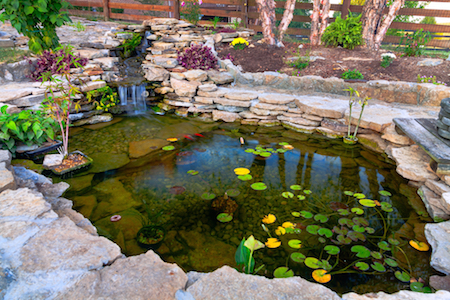
Ponds and outdoor water features are becoming very popular, and many people are looking at do-it-yourself ponds. A beautiful garden pond is easy to design and can be built in a weekend.
What are the choices?
- What area is available for the pond? Some types of pond will require more space.
Koi ponds, for example, not only need to be deep but they also need to be large enough to hold a minimum of 1000 gallons of water.
Water depth
- Goldfish are quite hardy and adapt well to smaller ponds.
- If you’re wanting to keep koi, your pond should be at least 3 feet deep. There’s no maximum depth. The depth is needed to allow the koi to survive extreme temperatures – the cold winter months and summer heat. Remember also that koi will double in size within 2 to 3 years.
- How many hours of sunlight does the pond area receive? If your pond will mainly contain aquatic plants, it’s important to locate your pond where it receives maximum sunlight. Some plants require all day sun, while others will happily survive with as little as 3 to 4 hours a day.
- Overcrowding in the pond doesn’t just refer to the number of fish you have. Thick vegetation contributes to algae growth.
Design and shape
Once you’ve chosen the area, design the shape of the pond by laying out a garden hose, (or string), or draw it on the ground with spray paint. One of the best ways to create a D-I-Y pond is to dig the area out and dig a shelf on the outside of the pond about a foot wide.
The pond itself can gradually slope down with shelves or terraces created every few feet. These terraces can be used to place your containers of aquatic plants.
The outside terrace is used to house the plumbing for the filtration and pump that’s necessary.
Pond liners

The pond will need a liner. One piece pre-fabricated liners are readily available that can be laid onto the ground making your job much easier and quicker.
- A simple and cost saving idea is to place old blankets underneath the lining to help prevent it being punctured when filled with water.
- Use rocks to hold the liner down.
Pots are needed to plant the aquatic and marginal plants incorporated into a pond. Floating plants don’t need to be potted. Specific plants have different soil needs. Follow directions for planting the water plants for best results.
Pond filters and pumps
A filter and pump are 2 must have items in your DIY pond. These help maintain the quality of the pond water, keeping plants and fish healthy. Without a filter and pump the pond will be invaded by algae. Plants will no longer thrive as oxygen is not being circulated throughout the pond and it will be a breeding ground for bacteria and insects.
